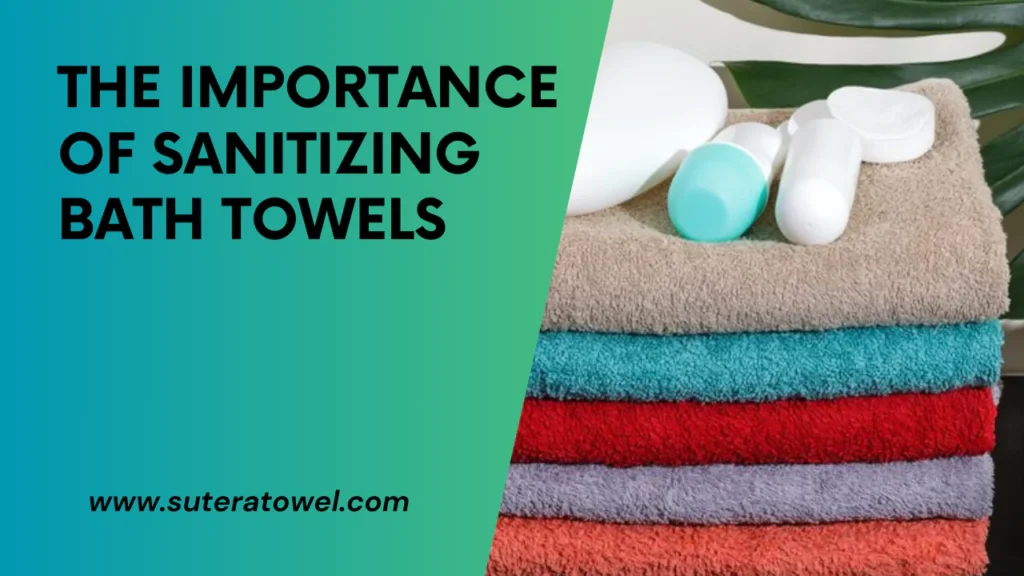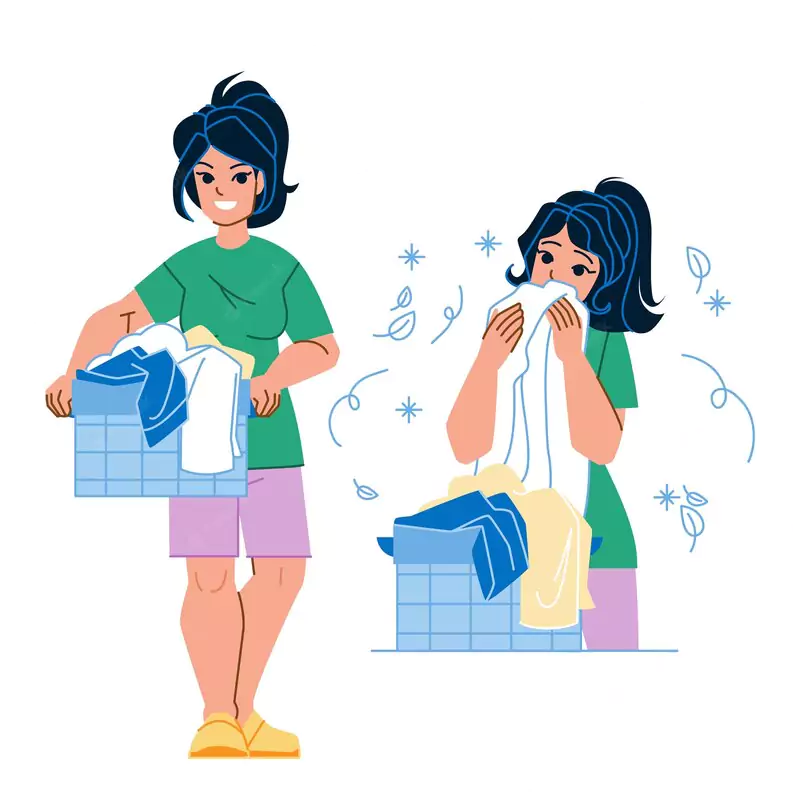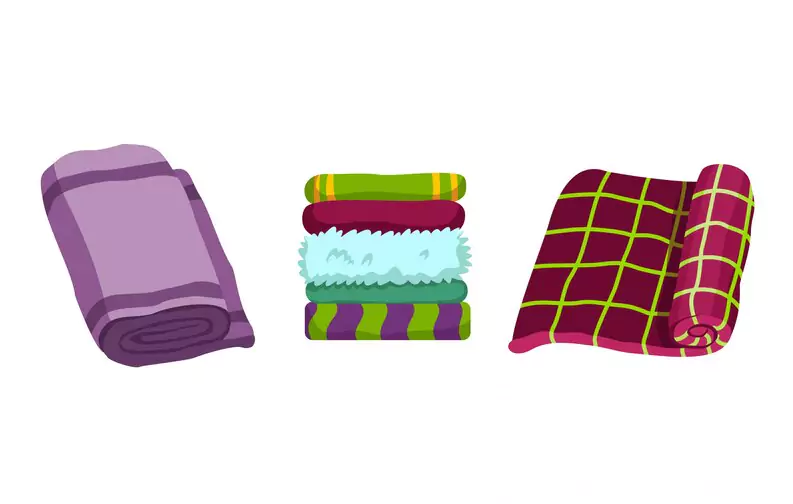To sanitize bath towels, wash them in hot water with detergent and bleach or vinegar, then dry them completely. Properly sanitizing bath towels is essential for maintaining cleanliness and preventing the spread of bacteria and germs.
Regular washing of towels is not enough, as they can harbor bacteria due to their exposure to moisture and body fluids. By following a simple sanitizing process, you can ensure that your bath towels remain clean and free from harmful pathogens.
We will discuss the steps you should take to properly sanitize your bath towels, including the temperature and detergent to use during washing, and additional tips for maintaining their cleanliness. Keep reading to learn how to keep your bath towels fresh and germ-free.
- 1 The Importance Of Sanitizing Bath Towels
- 2 Preparing Your Towels For Sanitization
- 3 Best Practices For Washing Bath Towels
- 4 Suitable Drying Methods For Germ-Free Towels
- 5 Additional Measures For Effective Sanitization
- 6 Storing Clean And Sanitized Bath Towels
- 7 Monitoring And Maintaining Towel Cleanliness
- 8 Extend The Life Of Sanitized Towels
- 9 Frequently Asked Questions For How To Sanitize Bath Towels
- 10 Conclusion
The Importance Of Sanitizing Bath Towels

Sanitizing bath towels is crucial for maintaining cleanliness and preventing the spread of bacteria. By following simple steps like washing in hot water and using a disinfectant, you can ensure that your towels are free from germs and safe for use.
Maintaining proper hygiene and cleanliness is essential for our overall well-being. While many of us focus on cleaning our bodies and homes, we often overlook an important item that comes into direct contact with our skin – bath towels. Regular laundering might not be enough to ensure the complete elimination of germs and bacteria from these frequently used items.
In this section, we will explore the potential health risks associated with using unsanitized bath towels and introduce you to the ultimate guide for germ-free laundry.
Why Regular Laundering Is Not Enough:
- Bath towels are a breeding ground for bacteria due to their ability to absorb moisture, which creates an ideal environment for germs to thrive.
- Regular laundering may remove dirt and grime, but it may not eliminate all the bacteria and fungi residing in the fibers.
- Over time, residual bacteria can accumulate, leading to a build-up of harmful pathogens that can cause skin infections, allergies, and even respiratory illnesses.
Understanding The Potential Health Risks:
- Bacteria such as Staphylococcus aureus, Escherichia coli (E. Coli), and Salmonella can be found on damp towels and can cause skin infections, including cellulitis and folliculitis.
- Fungi like Candida and Aspergillus can grow in moist environments, leading to skin irritations and infections, especially in individuals with compromised immune systems.
- Sharing towels can spread contagious conditions like ringworm, impetigo, and even hepatitis A.
To safeguard yourself and your family from these potential health risks, it is crucial to go beyond regular laundering and adopt effective methods to sanitize your bath towels. In the following sections of this ultimate guide for germ-free laundry, we will delve into various techniques and tips that will help you achieve clean, sanitized, and safe-to-use bath towels.
Remember, protecting your health starts with practicing good hygiene habits. So, let’s explore the world of bath towel sanitation together, leaving behind any worries about hidden germs and embracing a life free from potential health risks.
Preparing Your Towels For Sanitization

Ensure your bath towels are properly sanitized by following these steps: wash them with hot water and detergent, add a cup of white vinegar during the rinse cycle, dry them on high heat, and avoid using fabric softener.
Sorting And Separating Towels:
- It is essential to sort your bath towels before starting the sanitization process.
- Separate the towels based on their colors and fabric types.
- This will prevent any color bleeding or damage to delicate towels.
- You can group white towels together and colored towels separately.
- Moreover, consider separating towels used for different purposes, such as body towels and face towels.
Removing Any Stubborn Stains:
- Before sanitizing your bath towels, it is necessary to tackle any stubborn stains.
- Check each towel for stains and treat them individually.
- Apply a stain remover directly to the stained area and gently rub it in.
- Allow it to sit for a few minutes, then wash the towel as usual.
- It is important to always follow the instructions provided by the stain remover manufacturer.
Choosing The Right Detergent For Sanitization:
- When sanitizing your bath towels, it is crucial to choose the right detergent.
- Look for a detergent that has disinfecting properties to ensure maximum sanitization.
- Opt for a detergent that contains ingredients like hydrogen peroxide or bleach.
- These components are effective in eliminating bacteria and other germs from the towels.
- Make sure to follow the recommended amount of detergent based on the load size.
Understanding The Proper Temperature For Washing Towels:
- The temperature at which you wash your bath towels plays a significant role in sanitization.
- Hot water is the most effective in killing bacteria and viruses.
- Set your washing machine to a temperature of at least 140°F (60°C) for optimal results.
- However, always check the care label of your towels to ensure they can withstand higher temperatures.
- If your towels cannot be washed in hot water, opt for warm water and consider adding a disinfectant to compensate for the lower temperature.
Now that you have a better idea of how to prepare your bath towels for sanitization, it’s time to dive into the washing process.
Best Practices For Washing Bath Towels
Learn the best practices for washing bath towels to ensure they are properly sanitized. Follow these guidelines for a clean and germ-free towel that will leave you feeling refreshed after every use.
Maintaining clean and hygienic bath towels is essential for our overall well-being. By following these best practices for washing bath towels, you’ll ensure that they are not only fresh but also properly sanitized.
Using The Correct Water Temperature For Sanitization
- Hot water: Washing bath towels in hot water, typically above 140°F (60°C), helps to eliminate bacteria and allergens effectively.
- Warm water: If your towels are heavily soiled, warm water (around 90-105°F or 32-40°C) can still offer sufficient sanitization.
- Cold water: Cold water is suitable for washing less soiled bath towels, but it may not effectively eliminate certain germs and stains.
Measuring And Adding The Appropriate Amount Of Detergent
- Read the instructions: Refer to the detergent packaging for the recommended amount of detergent based on the load size and water hardness.
- Don’t overload: Avoid overloading your washing machine to ensure each towel gets properly cleaned.
- Pre-treat stains: If you notice stains on your bath towels, treat them with a stain remover before washing.
Selecting The Ideal Wash Cycle
- Regular cycle: For most bath towels, the regular or normal wash cycle is sufficient. It balances cleaning power and energy efficiency.
- Heavy-duty cycle: If your towels are heavily soiled or have embedded odors, opt for the heavy-duty or deep clean cycle.
- Delicate cycle: Delicate or gentle cycles are best suited for towels with delicate embellishments or made from more fragile materials.
Pre-Soaking For A Deeper Clean
- Optional pre-soak: For deeply embedded stains or odors, consider pre-soaking your bath towels before washing them.
- Fill a tub or sink: Fill a tub or sink with warm water and add a laundry booster or stain remover to help loosen dirt and grime.
- Soak time: Let your towels soak for 30 minutes to a few hours, then proceed with the regular washing process.
Avoiding Fabric Softeners And Other Additives
- Skip the fabric softener: Fabric softeners can leave residue on your towels, reducing their absorbency. Instead, opt for vinegar during the rinse cycle to soften and freshen your towels.
- Avoid additives: Avoid using additional additives like bleach unless necessary, as they may damage towel fibers over time.
- Eco-friendly options: Consider using eco-friendly laundry products that are gentle on the environment and your towels.
By following these best practices, you can ensure that your bath towels remain fresh, soft, and sanitary for your everyday use. Remember to read the care labels on your towels for any specific instructions and adjust the washing process accordingly.
Suitable Drying Methods For Germ-Free Towels

Discover effective drying methods for germ-free towels to ensure maximum cleanliness and hygiene. From air-drying in a well-ventilated area to using a hot dryer setting, these techniques will assist in sanitizing bath towels effectively.
Maintaining proper hygiene is crucial when it comes to bath towels, as they come into direct contact with our skin. After washing, the drying process plays a significant role in preventing bacterial growth. In this section, we will discuss the importance of dried towels and compare air drying to machine drying.
Additionally, we’ll explore the use of dryer sheets or balls for added cleanliness and freshness.
The Significance Of Dried Towels In Preventing Bacterial Growth
To keep your bath towels free from harmful bacteria, it is essential to ensure they are thoroughly dried. Here’s why:
- Moisture removal: Drying eliminates the moisture that could become a breeding ground for bacteria. When towels stay damp for extended periods, bacteria can multiply quickly, leading to unpleasant odors and potential skin infections.
- Inhibiting bacterial growth: Proper drying inhibits the growth of bacteria by removing the favorable environment they need to thrive. Providing dry conditions reduces the risk of contamination and helps maintain optimal hygiene levels.
- Extended usability: By drying your towels adequately, you extend their usability. Freshly cleaned, dry towels feel more comfortable against the skin, enhancing your overall bathing experience.
Air-Drying Versus Machine Drying
The debate between air drying and machine drying has perplexed many when it comes to finding the best way to dry bath towels. Let’s explore the pros and cons of each method:
Air-Drying:
- Cost-effective: Air-drying is an economical method as it requires no electricity usage, minimizing energy expenses.
- Gentle on fabrics: Hanging towels to dry naturally prevents excessive heat exposure, which can be damaging to delicate fibers, prolonging their lifespan.
Machine Drying:
- Quick and convenient: Machine drying offers a faster drying time, ensuring that your towels are readily available for use.
- Optimal for fluffy towels: Tumble drying in the machine fluffs up your towels, giving them a soft and cozy feel.
Considering The Use Of Dryer Sheets Or Balls
While not directly related to the drying process, the use of dryer sheets or balls can enhance the cleanliness and freshness of your bath towels. Here’s how:
- Softening and reducing static: Dryer sheets or balls can make towels softer and reduce static, enhancing their overall texture.
- Adding fragrance: Some dryer sheets are infused with pleasant scents that can leave your towels smelling fresh and clean.
Remember, when using dryer sheets or balls, ensure that they are suitable for use with towels and follow the manufacturer’s instructions for optimal results.
By understanding the significance of properly drying bath towels and weighing the pros and cons of different drying methods, you can ensure that your towels remain germ-free and provide a hygienic experience after each use.
Additional Measures For Effective Sanitization
Ensure effective sanitization of your bath towels with additional measures that eliminate germs and bacteria, promoting a hygienic environment in your bathroom.
Maintaining clean and bacteria-free bath towels is essential for a healthy bathing experience. While regular washing is a good start, there are additional measures you can take to ensure effective sanitization. In this section, we will explore the role of bleach or alternative disinfectants, incorporating vinegar or baking soda into the cleaning routine, utilizing laundry sanitizing additives or products, and the importance of regular washing machine maintenance.
The Role Of Bleach Or Alternative Disinfectants:
- Bleach: Diluting bleach in water according to the instructions on the label and adding it to the wash cycle can effectively kill bacteria and viruses on bath towels.
- Alternative disinfectants: If you prefer to avoid bleach, there are alternative disinfectants available such as hydrogen peroxide or pine oil. Follow the instructions provided and add them to the wash cycle to eliminate harmful microorganisms.
Incorporating Vinegar Or Baking Soda Into The Cleaning Routine:
- Vinegar: Adding white vinegar to the rinse cycle can help remove soap residue and soften the towels. It also has antibacterial properties that can aid in killing germs.
- Baking soda: Including baking soda in the wash cycle helps neutralize odors and can act as a natural fabric softener. It contributes to deep cleaning, ensuring your towels are hygienically clean.
Utilizing Laundry Sanitizing Additives Or Products:
- Laundry sanitizing additives: There are various laundry sanitizing additives available on the market that can be used along with your regular detergent. These products are specially designed to kill bacteria, viruses, and mold, providing an extra layer of protection.
- Sanitizing laundry products: You can also opt for detergents that have built-in sanitizing properties. These products offer a convenient way to ensure your bath towels are thoroughly sanitized during every wash.
Importance Of Regular Washing Machine Maintenance:
- Clean the machine: Regularly clean your washing machine, especially the detergent dispenser and the rubber gasket, where moisture can accumulate and lead to mold growth. Wipe down the drum and door seal to remove any lingering debris or residue.
- Run maintenance cycles: Run maintenance cycles periodically, using hot water and bleach or vinegar, to clean the internal parts of the machine. This helps eliminate any bacteria buildup and ensures optimal performance.
- Check the filter: Don’t forget to clean or replace the filter, as a clogged filter can affect the efficiency of your washing machine and hinder proper cleaning and sanitization.
It’s important to remember that by incorporating these additional measures into your towel sanitization routine, you can enjoy the benefits of cleaner, fresher, and bacteria-free bath towels.
Storing Clean And Sanitized Bath Towels
Discover the best way to keep your bath towels clean and sanitized to maintain a healthy and hygienic bathroom environment. Follow these simple steps to ensure your towels are free from bacteria and ready for use.
The Significance Of Proper Storage In Maintaining Cleanliness
Proper storage of clean and sanitized bath towels is essential to maintain their cleanliness and prevent the growth of bacteria and mildew. When towels are not stored correctly, they can become breeding grounds for microbes and develop musty odors. To ensure your bath towels remain fresh and sanitized, follow these tips for storing them appropriately:
Selecting The Right Storage Location
Choosing the right storage location for your bath towels is crucial to maintaining their cleanliness. Consider the following factors when deciding where to store your towels:
- Avoid damp places: Store your towels in a dry area to prevent the growth of mold and mildew. Damp environments can create the perfect conditions for microbes to thrive.
- Adequate ventilation: Ensure that the storage location has proper air circulation to prevent the buildup of moisture. Good airflow helps in keeping the towels dry and fresh.
- Away from direct sunlight: Sunlight can fade the colors of your towels and weaken the fabric. Find a location away from direct sunlight to preserve the quality of your towels.
- Clean environment: Make sure the storage area is clean. Dust and dirt can settle on towels over time, compromising their cleanliness.
- Temperature control: Extreme temperatures can affect the quality of your towels. Avoid storage areas with excessive heat or cold, as they can lead to deterioration of the fabric.
Tips For Preventing Musty Odors And Mildew Growth
To prevent musty odors and the growth of mildew on your bath towels, follow these tips:
- Allow towels to fully dry: Before storing your towels, ensure they are completely dry. Moisture trapped in folded towels can lead to unpleasant odors and the growth of mildew. Hang them on towel racks or hooks until they are thoroughly dry.
- Don’t overcrowd: Avoid overcrowding your storage area to allow towels to breathe. Overcrowding can limit air circulation, leading to moisture buildup and musty odors.
- Use breathable storage containers: If using storage containers, opt for breathable options such as canvas bags or open-woven baskets. This helps to prevent moisture accumulation and allows proper airflow.
- Consider using lavender sachets or essential oils: Infuse your storage area with pleasant scents by placing lavender sachets or a few drops of essential oil on a cloth near your towels. These natural fragrances can help keep the towels smelling fresh.
- Wash towels regularly: Regularly washing your towels not only removes dirt and bacteria but also helps prevent musty odors. Follow the manufacturer’s instructions for washing and drying to maintain their quality.
By following these tips for storing clean and sanitized bath towels, you can ensure their longevity, freshness, and cleanliness. Proper storage practices will help you enjoy a soft, hygienic towel every time you step out of the shower.
Monitoring And Maintaining Towel Cleanliness

Maintain towel cleanliness by properly sanitizing bath towels. Follow these essential steps to ensure your towels are free of germs and bacteria, keeping you and your family safe and healthy.
Signs Of Towel Contamination
- Foul Odor: If your bath towels emit a stale or musty smell, it could indicate bacterial growth and contamination.
- Discoloration and Stains: Noticeable discoloration or stubborn stains on your towels might indicate the presence of dirt or microbes.
- Skin Irritation: If you experience skin irritation or itching after using a towel, it could be a sign of bacterial or fungal contamination.
Establishing A Regular Washing Routine
Maintaining clean towels requires regular washing. Follow these steps:
- Wash towels after 3-4 uses to prevent the buildup of bacteria and dirt.
- Use warm water and an appropriate detergent to ensure effective cleaning.
- Avoid overcrowding the washing machine, as it can hinder proper cleaning.
- Add vinegar or baking soda to the washing cycle to enhance odor removal.
- For heavily soiled towels, pre-soak them in a mixture of warm water and detergent.
Ensuring Proper Hygiene For Prolonging Towel Cleanliness
To extend towel cleanliness and prevent contamination, follow these practices:
- Avoid sharing towels with others to minimize the risk of spreading bacteria or infections.
- Hang towels to dry thoroughly between each use to discourage bacterial growth.
- Choose a well-ventilated bathroom area that allows towels to dry quickly.
- Avoid leaving damp towels in a pile, as it can create a breeding ground for bacteria.
- Replace towels after a certain period, as even with regular cleaning, they can deteriorate over time.
Remember, the key to maintaining towel cleanliness is establishing a regular washing routine, monitoring for signs of contamination, and practicing good hygiene habits. By following these guidelines, you can ensure that your bath towels stay fresh, hygienic, and ready for use.
Extend The Life Of Sanitized Towels
Learn how to extend the life of your sanitized bath towels with these simple tips. Keep your towels bacteria-free and fresh for longer, ensuring a hygienic and enjoyable bathing experience.
Proper Towel Care And Maintenance
Proper care and maintenance of your bath towels is essential to extend their lifespan and keep them sanitized. By following these tips, you can ensure that your towels remain fresh, clean, and absorbent for a long time:
- Wash towels every three to four uses to maintain their cleanliness and prevent the buildup of bacteria or odors.
- Use warm water and an appropriate amount of detergent while washing towels. Avoid using fabric softeners as they can reduce the towel’s absorbency.
- Opt for gentle or delicate cycles when washing towels to prevent unnecessary wear and tear.
- Air-drying your bath towels instead of using a dryer can help preserve their fabric quality and maintain their fluffiness. If using a dryer, choose a low-heat setting.
- Avoid using bleach or harsh chemicals on your towels as they can weaken the fibers and affect their softness.
- Shake out wet towels before hanging them to dry, as this helps prevent mildew and mold growth.
- Store towels in a well-ventilated area to keep them dry and fresh. Avoid leaving them in humid spaces, which can promote bacteria growth.
Tips For Preserving Towel Quality And Absorbency
To ensure your bath towels stay in optimal condition and retain their absorbency, follow these additional tips:
- Avoid overloading the washing machine, as overcrowding can reduce the effectiveness of the cleaning process.
- Refrain from using towels to clean up spills or as substitutes for cleaning rags, as they are designed for personal use and may accumulate dirt and stains over time.
- Use color-safe bleach only when necessary and in accordance with the manufacturer’s instructions. Overusing bleach can weaken the fabric and cause color fading.
- Keep towels separate from clothing items with zippers or Velcro to prevent snagging or damage.
- Rotate your towel collection regularly, as frequent use can result in wear and tear. By allowing towels to rest between uses, you can promote longevity.
- Avoid hanging wet towels to dry in direct sunlight, as this can cause color fading.
By implementing these towel care and maintenance tips, you can increase the lifespan of your sanitized towels, saving you money and ensuring you consistently enjoy fresh and absorbent bath linens.
Frequently Asked Questions For How To Sanitize Bath Towels
What Is The Best Way To Sanitize Towels?
The best way to sanitize towels is to wash them in hot water with detergent.
What Kills Bacteria On Towels?
Regular washing with hot water and detergent effectively kills bacteria on towels.
How Do You Wash And Sanitize Bath Towels?
To wash and sanitize bath towels: 1. Separate towels by color and wash in hot water with detergent. 2. Add a cup of vinegar or bleach to remove odors and kill bacteria. 3. Dry towels thoroughly in a hot dryer or under the sun.
4. Avoid using fabric softeners as they can reduce towel absorbency.
How Do You Disinfect Bath Towels Without Bleach?
To disinfect bath towels without bleach, wash them in hot water, use vinegar or hydrogen peroxide, and hang them to dry in direct sunlight.
Conclusion
Properly sanitizing bath towels is crucial for maintaining good hygiene and preventing the spread of germs. By following a few simple steps, you can ensure that your towels are clean and ready for use. Firstly, always separate your towels from other laundry items to prevent cross-contamination.
Secondly, use hot water and a high-quality detergent to effectively eliminate bacteria. Additionally, consider adding a cup of white vinegar during the rinse cycle to remove any residual soap and improve softness. Furthermore, drying towels thoroughly is essential. Whether air-drying or using a dryer, make sure they are completely dry to prevent the growth of mold and mildew.
Lastly, regularly washing your towels and replacing them when necessary will help maintain cleanliness and keep your bath linens fresh and hygienic. By following these tips, you can enjoy clean and sanitized bath towels that are both comfortable and safe for daily use.

